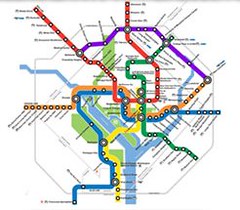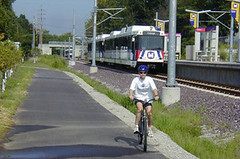Railbanking works: light rail approved for DC 'burbs

Posted January 29, 2009 at 1:40PM
I am really happy that the badly needed light rail Purple Line transit proposed for Montgomery and Prince George's Counties in the Maryland suburbs just north of DC has finally been given the go-ahead by the Montgomery County Council.  Currently, DC's Metro rail transit system is a hub-and-spoke system connecting suburban corridors to urban corridors and to downtown. It works extremely well for that, but not for suburb-to-suburb travel.
Currently, DC's Metro rail transit system is a hub-and-spoke system connecting suburban corridors to urban corridors and to downtown. It works extremely well for that, but not for suburb-to-suburb travel.
The Purple Line, which will connect four northern "spokes" of the heavy rail system (see map), will help remedy that. It will also help spur revitalization of parts of Prince George's County to DC's northeast, which has lagged behind other parts of the region. As Katherine Shaver wrote in The Washington Post:
"Some transportation experts say the east-west transit line could help transform struggling Maryland communities such as Langley Park and Riverdale Park in the same way that Metro helped bring offices, retail, restaurants and apartments to Northern Virginia's Rosslyn-Ballston corridor."
I don't necessarily call myself an expert, but I believe it will definitely help.
I have been very disappointed in some of my cycling friends who opposed the project, because it will partly run along a 4-mile section of the unpaved Georgetown Branch Trail (despite its name, the trail is not near Georgetown).  They have believed that the Purple Line will ruin their enjoyment of the trail, even though pleasant cycling routes run alongside transit lines in many parts of the country (see photos). That will almost certainly be the case here as well, although the landscaping along the trail will need to change. I think the light rail line will, most likely, improve the trail's usefulness, since the Georgetown Branch has been very poorly maintained over the years.
They have believed that the Purple Line will ruin their enjoyment of the trail, even though pleasant cycling routes run alongside transit lines in many parts of the country (see photos). That will almost certainly be the case here as well, although the landscaping along the trail will need to change. I think the light rail line will, most likely, improve the trail's usefulness, since the Georgetown Branch has been very poorly maintained over the years.
What the opponents either have ignored or never knew is that the only reason the Georgetown Branch was available to recreational users in the first place is because it was being conserved for future rail use. The concept is called "railbanking," and it has been championed since mid-1980s by a wonderful nonprofit organization, the Rails-to-Trails Conservancy, along with others. RTC explains the concept:
"Railbanking is a voluntary agreement between a railroad company and a trail agency to use an out-of-service rail corridor as a trail until some railroad might need the corridor again for rail service.
Because a railbanked corridor is not considered abandoned, it can be sold, leased or donated to a trail manager without reverting to adjacent landowners."
For a fully documented explanation, go here.
The Georgetown Branch was once a heavy rail corridor and, like other "rail-trails" across the country, was preserved under the provisions of the National Trails System Act so that it would be available again for rail use if needed. Initiatives like the Purple Line are exactly what the framers of that legislation had in mind. (Two other popular rail-trails here are also named after their former railroad lines, the Washington & Old Dominion and the Capital Crescent.)
The railbanking system works, and commuters in Maryland are going to be the beneficiaries. May the model continue to proliferate.
Many thanks to my NRDC colleague Samir Succar for reminding me about this story.